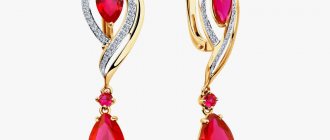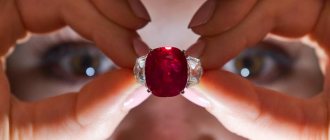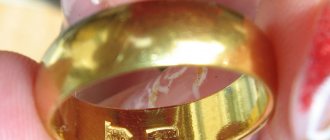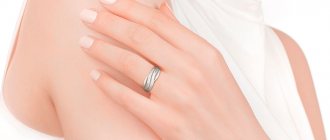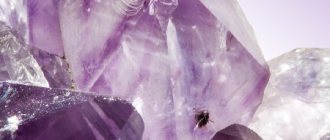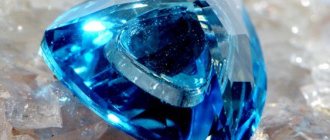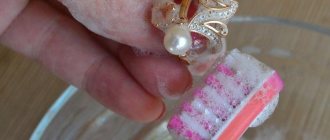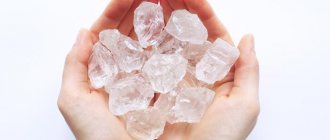Faceted ruby
Ruby
- mineral, Al2O3, a type of corundum red, transparent or translucent, also clouded to opaque, translucent at the edges. Outdated names are “lal”, “red yacht”. The red color is given by an admixture of chromium. Red corundums are called rubies, blue ones are called sapphires. “Star-shaped” varieties of ruby and sapphire with a well-defined asterism effect are processed as cabochons.
- Structure
- Properties
- Morphology
- Origin
- Application
- Classification
- Physical properties
- Optical properties
- Crystallographic properties
See also:
Ruby
- price and medicinal, magical properties
Physical properties and structure of diamond
STRUCTURE
Crystal structure of ruby
The crystal structure of Al2O3 is shown in the figure in the form of Al2O3 groups at the corners of two rhombohedrons that make up the unit cell. Despite its apparent complexity, it has a fairly simple structural diagram. Oxygen ions are in a dense hexagonal packing and are arranged in sheets perpendicular to the triple axis, superimposed on one another. Al cations are located between two such sheets in the form of hexagons (with an unoccupied center), filling two-thirds of the octahedral voids (i.e., the voids between six oxygen anions, three of which belong to one, and the other three, rotated relative to the first by 180°, - another sheet of oxygen ions). In this case, the groups of every three oxygen ions form a common face for two adjacent octahedra in adjacent sheets. It is characteristic that the oxygen sheets are superimposed on each other in such a way that in each column of octahedra two occupied ones also alternate with one unoccupied one, and the pairs of occupied octahedra form helical triple axes vertically.
Growing ruby crystals at home using the Verneuil method
Author of the idea: Mikhail Babin E-mail Website: https://rubin-bmm.narod.ru
I have already published three of my ideas on this site (Stained glass from colored glass, Making mosaic panels and tables, Growing mosaic panels in an incubator). The new idea, which I called “Growing Ruby Crystals at Home,” was born similar to idea 1404 in the process of psychological counseling using the techniques I used to develop creative thinking. It was thanks to these techniques that this new idea was born in collaboration with my other now business partner. I will not go into detail about what problems a young man named Alexander came to me with (now it doesn’t matter), but the result of our joint work was the birth of this idea of a home business.
At the beginning, I came across information that, it turns out, almost all the precious stones that are sold as part of jewelry in our standard jewelry stores are of artificial origin! This does not mean at all that we are being deceived.
Synthetic gemstones are almost completely indistinguishable from natural stones in their chemical composition and physical properties. The whole problem. It turns out that among natural precious stones, not all have sufficient purity and other jewelry qualities to be honored with being presented in jewelry stores, and in laboratory or factory production conditions the technological process can be fine-tuned so that all crystals grown in the laboratory will have almost identical jewelry characteristics.
And they are much cheaper to produce than their “colleagues” of the same quality, mined in deep and life-threatening working mines. In addition, deposits of certain minerals are not scattered in abundance evenly throughout the globe, but are concentrated, as a rule, in a few places.
Then the idea flowed by analogy with stained glass and mosaics. If on the Internet I came across offers for these services from large reputable companies, with solid production space and cash flow, then I asked myself the question - why can’t I make small stained glass windows (inserts in interior doors, wall lamps, etc.) literally? on your desk?
I studied the technology, puzzled over how it could be simplified for home use, conducted a certain number of experiments - and got the result!
Likewise, Alexander and I began to creatively rework the idea of growing gemstone crystals at home. We studied (at an introductory level) different methods, and settled on the method of the French scientist Auguste Verneuil, who more than 100 years ago created an original method and equipment that made it possible to grow ruby crystals weighing 20-30 carats in 2-3 hours. This was an outstanding achievement of science and technology, not only because it made it possible to artificially produce such a valuable material in the required quantities, but also because it opened up the prospect of synthesizing and growing crystals of other precious stones.
The success of O. Verneuil was preceded by almost half a century of research on the synthesis of ruby.
The simplicity and reliability of the Verneuil method led to the rapid organization of industrial production of these crystals, first in France, and later in almost all highly developed countries of the world.
The first picture shows the very principle of operation of the Verneuil method (doesn’t it, it all looks quite simple!), and the second picture shows the Verneuil apparatus.
Verneuil apparatus for growing ruby crystals at home
It looks quite difficult, even at first it instills some fear - like, I’ll never be able to do something like this! But these are false fears. After all, we should remember once again that the inventor created his technology more than 100 years ago!
Naturally, he did not have at his disposal those electrical and mechanical “tricks” that are available to any home master at the present time!
It was this problem - how to simplify the Verneuil apparatus through the use of modern electrical components and mechanisms that are widely available and create a “kitchen” version of the apparatus - that we began to work on.
And we succeeded!
More detailed information on our “kitchen” version of the Verneuil apparatus has been published on the website rubin-bmm.narod.ru.
Using the Verneuil method, you can grow crystals not only of ruby, but also of blue, white (transparent) and yellow topaz (as well as other shades if desired).
I am publishing a detailed description of the “kitchen” option (with Alexander’s consent) as the main generator of the idea and am not at all afraid of competition from those enthusiasts who decide to follow this idea. The reason is very simple: currently, artificial precious crystals are grown in many countries around the world, but if you go to a jewelry store, it will immediately become obvious that prices are still “biting.” And market saturation is apparently still very, very far away. And even if after reading this information there are several thousand enthusiasts, then with our “home” production we cannot do anything special in this market segment. Therefore, the results of our research can be published without fear. On the contrary, if something like the “Association of Home Crystal Planters” appears on the Internet :-), then it will be even more interesting and useful for everyone, since, as you know, two heads are good, but two thousand, one can confidently assume, is much better. And some of these heads may turn out to be much lighter, and their ideas will help everyone interested in further simplifying and improving the device, and turning it from a “kitchen”, for example, into a “bedside table” :-).
Now a few words about the economic efficiency of the project. To grow a ruby crystal weighing 20-30 carats (4-6 grams!), it will take 3 hours and approximately 3 kWh of electricity. Calculate how much it costs in your region. Think. that the result will be a figure of less than 10 rubles. The cost of 6 grams of aluminum oxide powder and 0.2 grams of chromium oxide generally cannot cost more than 50 kopecks.
So if you, dear reader, offer even a raw ruby crystal to an interested jeweler, you don’t need to have the head of Soros to understand that the profit from the deal will be very substantial. Well, if one of the handicraft men makes his own wife or girlfriend happy with rubies and topazes, then the psychological dividends from such “investments” cannot be calculated at all! :-).
A few more words about the legal legality of such proceedings. Of course, we still have to thoroughly consult with lawyers, but the law of the Russian Federation “On PRECIOUS METALS AND PRECIOUS STONES” that I reviewed (last amendment dated July 18, 2005 N 90-FZ) says very specifically that the object of regulation of this law is “precious stones - natural diamonds, emeralds, rubies, sapphires and alexandrites, as well as natural pearls in raw (natural) and processed form. Unique amber formations are equated to precious stones in the manner established by the Government of the Russian Federation. This list of precious stones can only be changed by federal law.” I specifically highlighted the word “natural”. And nothing is said about synthetic ones.
So grow ruby crystals at home with peace of mind.
PROPERTIES
Ruby
Trigonal system. Hardness 9, density 3.97 - 4.05, for more details see corundum. The red color is given by the content of chromium impurities in the form of Cr3+ ions (from hundredths to 2%). Easily recognized by the shape of the crystals, shading on the edges, often characteristic bluish-gray color and high hardness. It differs from similar disthene (Al2SiO5) in the absence of perfect cleavage and high hardness. Ruby can be distinguished from red spinel by the shape of its crystals, and in irregular grains - only under a microscope. Doesn't melt under a blowpipe. Does not dissolve in acids.
How to distinguish a ruby from a garnet visually by color
Usually, a variety of garnet - pyrope or almandine - is passed off as a genuine stone.
With a set of certain knowledge and tools, finding out the truth will not be difficult.
Here are some tips on how to distinguish a ruby from a garnet:
- If it is possible to use a special Heidinger magnifying glass, then minerals can be distinguished based on dichroism. In static polarized light, corundum crystals will change color to a darker one. This is clearly visible when changing the angle of view. Garnets do not have this property.
- In ultraviolet rays, it is even easier to identify a real ruby: it luminesces with an orange glow. Pyropes and almandines do not exhibit such a glow.
- An ordinary magnifying glass is also a good helper, as long as the lighting is of high quality. If you look closely at a ruby crystal under such conditions, you will clearly see needle-shaped inclusions. And for a stone in the shape of a cabochon, they also give the optical effect of a star of 6 rays.
- The uniformity of the natural color of stones is an important characteristic in their distinguishability. Natural stone is not uniform, whereas garnet has an even color distribution.
- The strength of ruby is very high; its crystal can scratch, for example, topaz or crystal. Whereas garnet is capable of “inheriting” only on the crystal surface.
- The sparkle of a ruby is akin to that of a diamond, while garnet has a soft, oily sheen.
Here are the main features that distinguish gems that are similar in appearance but completely different in mineral type.
These tips are quite applicable not only to garnet imitation, but also to other natural stones that they try to pass off as natural rubies.
MORPHOLOGY
Ring with ruby
It occurs in the form of barrel-shaped, dipyramidal and tabular pseudohexagonal crystals, separately disseminated grains and granular aggregates. The faces of prisms, dipyramids and pinacoids are often covered with rough oblique shading. Typically, fairly well-formed barrel-shaped, columnar, pyramidal and lamellar crystals are observed, sometimes reaching large sizes (up to a decimeter in diameter). The most common faces of the hexagonal prism {1120}, hexagonal dipyramids {2241}, {2243}, rhombohedron (1011} and pinacoid {0001}. Often the faces of prisms and dipyramids, as well as the faces of the pinacoid, are covered with oblique shading, and in other cases it is observed hatching in the horizontal direction due to twinning along the pinacoid.
ORIGIN
Ruby crystals, 1.3 cm, Russia, North Karelia, Loukhsky district, Hit Island
Primary deposits are in crystalline marbleized limestones, plagioclasites and mica, which developed over ultrabasic rocks. Sometimes found in alumina-rich and silica-poor deep igneous rocks - corundum syenites and anorthosites in association with feldspars, occasionally in other rocks (andesites, basalts, etc.). Corundum-containing syenite pegmatites of industrial importance are also known. Contact-metasomatic corundum deposits are formed in crystalline limestones adjacent to igneous rocks. The main deposits of rubies are located in Myanmar (Mogok), Thailand, Sri Lanka (Ratnapura), Afghanistan (Jegdalek), Kenya and Tanzania (upper reaches of the Umba River). The bulk of precious varieties are found in placers. Since ancient times, it has been mined in the Pamirs along with pink spinel (Kukhilal deposit, Tajikistan. In Russia it is noted in the Urals (Rai-Iz, Pol. Ural; Murzinka, Middle Ural, etc.)
APPLICATION
Ring with ruby
A category I gemstone, used in expensive jewelry. High-quality specimens are valued more than diamonds. Red corundums are called rubies, blue ones are called sapphires. Light-colored sapphires or colorless corundum of jewelry quality are called Leucosapphire. "Star" or clouded varieties of ruby and sapphire with a pronounced asterism effect are cut into cabochons. It is also widely used in instrument making and laser technologies (mainly artificial rubies are used). Laser emission from ruby in the red region of the spectrum is associated with quantum transitions between energy levels of the Cr3+ ion, and with transitions between spin sublevels - the action of ruby as a quantum amplifier of radio waves (maser). Currently, large quantities are produced artificially (the method of artificially producing rubies was invented in 1835).
Ruby - Al2O3
| Molecular weight | 101.96 g/mol |
| origin of name | late lat. rubinus, from lat. rubeus - red |
| IMA status | valid |
How to grow artificial ruby
Growing synthetic rocks can turn from a fun hobby into a real home business idea. There is a well-known way to make a ruby using various salts or even sugar. The process will take quite a long time, and the quality of the resulting crystal ultimately does not satisfy many.
To set up home ruby production, you should purchase a special Verneuil apparatus. This scientist was the first to make a stone that resembles a real gem in composition and quality. Literally before our eyes, a ruby up to 30 carats in size grows, which amazes with its beauty and attractiveness.
The technology is quite simple and can be done by anyone who wants to do this business.
- An aluminum dioxide salt containing an admixture of chromium oxide is placed in the system's storage tank.
- An oxygen-hydrogen burner melts the mixture.
- The crystal “grows” literally before our eyes.
The color of the resulting stone can be adjusted independently by selecting different salts. This type of work requires care and consistency. The resulting crystals lend themselves perfectly to further processing and polishing. They turn out very beautiful and transparent. They are happily bought by jewelers to create various jewelry, craftsmen who make interesting compositions and crafts.
The resulting synthetic rubies are, of course, not jewelry. Professionals have simple ways to check the authenticity of the material, but even with a visual inspection they see the characteristics inherent in the synthetic analogue.
If you decide to grow crystals and sell them in the future, such activities should be licensed, guided by legal norms.
How to grow rubies from sugar
From small sugar crystals you can also grow worthy analogues of an expensive ruby. The solution must be made using the same technology as with salt. Next, lower the cotton wool into the composition and wait until crystals begin to form on it.
Please note that the active growth of a future ruby may slow down significantly. This indicates that the sugar concentration in the solution has begun to decrease. To restore the growth process, add a little more sugar to the water.
You can experiment with the shades of the stones you grow. To do this, add food coloring to the solutions.
To make the crystal look even more impressive, use a wooden stick instead of a thread or cotton cord.
- Prepare syrup of the required consistency and temperature of 50 degrees.
- Dip a wooden stick in it and roll it well in sugar. Try to leave as many sweet grains as possible on the surface, the final result depends on this.
- Pour the finished syrup into a clean container (it’s better to take a glass glass).
- Add food coloring of the desired shade in the required quantity.
- Place a stick in the glass, make sure that it does not touch the walls of the container, otherwise the crystal will turn out ugly. For additional fixation, use a sheet of paper, placing it on top of the stick.
- Leave the preparation for about 7 days. Make sure that the crystal growth does not slow down. In a week, you will have bright crystals that can even be used as a dessert, because there are no foreign additives in them.
Such an experiment, of course, is unlikely to become an idea for business, but children can be involved in the work process. They'll love growing colorful ruby lollipops for themselves and their friends. You can make various crafts from ready-made crystals without limiting your creative imagination.
PHYSICAL PROPERTIES
| Mineral color | red |
| Stroke color | white |
| Transparency | transparent, translucent |
| Shine | glass |
| Cleavage | imperfect |
| Hardness (Mohs scale) | 9 |
| Kink | splinter-like, conchoidal |
| Strength | fragile |
| Density (measured) | 3.99 - 4.10 g/cm3 |
| Radioactivity (GRapi) | 0 |
Characteristics of ruby
Methods for determining the authenticity of a stone are based on knowledge of its physical properties:
- High strength. The mineral belongs to igneous rocks, the hardness is 9 according to Mohs - slightly lower than that of diamond. It is impossible to leave scratches on this stone. Even when hitting a hard surface (glass or any metal), the mineral will not crack.
- According to the accepted density scale, the magma group belongs to 9 out of 10 subgroups. This means that it is quite easy to work, which is why the edges of the gem are always smooth and defined.
- A real ruby has a shade from soft pink to dark burgundy; specimens with a transitional color are often found.
- If you look deep into the scarlet stone, you will notice a glow due to the chromium content.
There are several more features that distinguish natural crystal from artificial fakes.
- A ruby with an asterism effect is difficult to fake: when illuminated, the outline of a star is visible inside.
- "Pigeon's Blood" This is the name given to one of the most expensive varieties of rich red color with a purple tint.
It is quite difficult to determine the value of this precious mineral by eye, so it is worth using special methods and devices.

